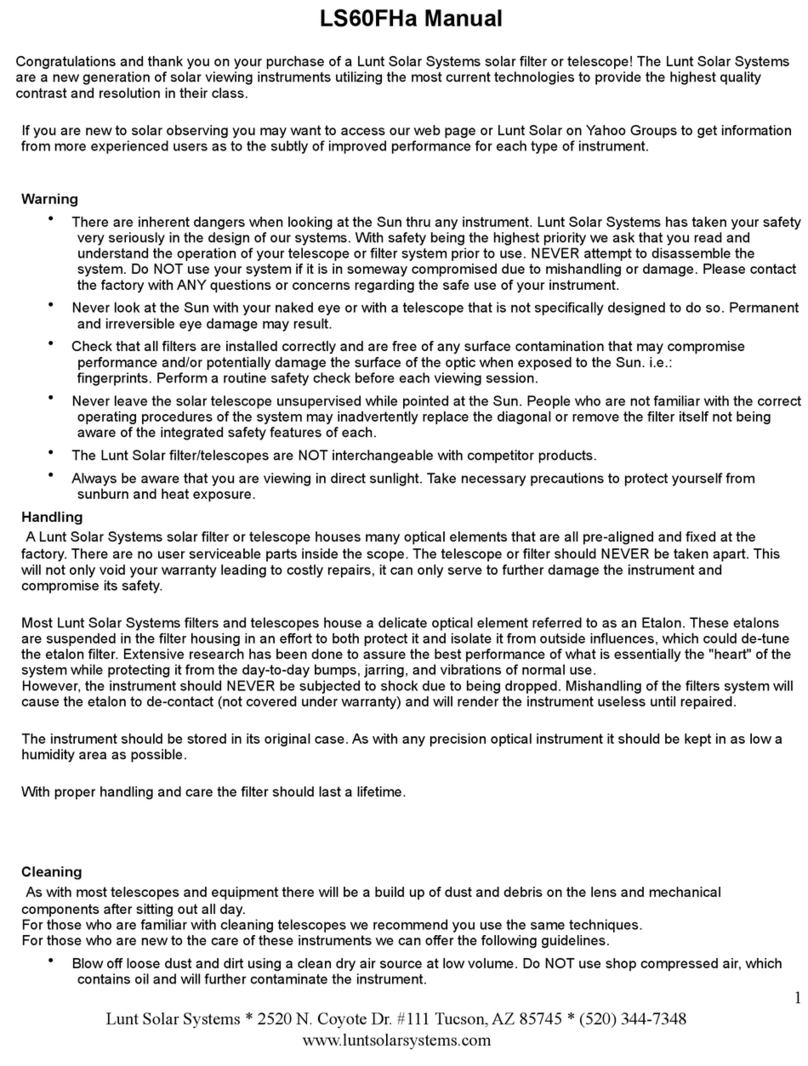•Stubborn particulates can be brushed from the surface with a static free lens brush. Use gentle sweeping motions.
•Fingerprints and smudges can be removed using lens tissue or a Kleenex type tissue product. Fold the tissue or
cloth to make a "pad", apply a cleaning product to the end of the pad dampening it evenly (do not apply solution to
the lens), wipe in circular motion starting at the center and working around the edge and off in one complete
motion. Be firm, but do NOT rub. Blow lightly to help remove residual solution before it "spots" the surface.
Residual dust from the cloth can be blown off.
•Consult your local dealer or call Lunt Solar Systems with any questions or concerns.
•Do NOT use Acetone or strong degreaser type products, household cleaning agents, paper towels, tissues with
added scent or color (plain tissues only), or bleach or acidic products which will damage the anodized surfaces.
What am I looking at?
The Sun is active on a daily basis. During solar maximum the Sun will put on awe inspiring displays that include x-class
flares, prominences, surface filaments, etc…
Here is a brief overview of those terms, which will help the observer explain what they have seen.
•Prominences: These look like eruptions from the disk (edge) of the Sun. Prominences can be small spiky looking
details, or large cloud like detail with fine feather like internal features. They are, in fact, Ionized hydrogen
emissions being projected from the limb. Prominences are anchored to the Sun's surface in the mesosphere, and
extend outwards into the Sun's troposphere.
•Filaments: These are string like features on the surface of the Sun. At high resolution they take on a 3D effect due
to the cooler aspect of the filament contrasted against the bright, hotter, Sun. They are actually prominences being
viewed against the surface.
•Spicules: A spicule is a dynamic jet of about 500km diameter on the Sun. It moves upwards at about 20 km/s from
the photosphere. Father Angelo Secchi of the Vatican Observatory in Rome discovered them in 1877. The
chromosphere is entirely composed of spicules. These features can be seen as "fur" around the edge of the disk.
•Plage: This is a bright region in the chromosphere of the Sun, typically found in regions of the chromosphere near
sunspots. The plage regions map closely to the faculae in the photosphere below, but the latter have much smaller
spatial scales. Accordingly plage occurs most visibly near a sunspot region. Faculae have a strong influence on
the solar constant, and the more readily detectable because chromospheric plage areas traditionally are used to
monitor this influence. In this context "active network" consists of plage-like brightening extending away from
active regions, as their magnetism appears to diffuse into the quiet Sun, but constrained to follow the network
boundaries.
•Solar Flares: A solar flare is a violent explosion in the Sun's atmosphere. Solar flares take place in the solar corona
and chromospheres, heating plasma to tens of millions of Kelvin and accelerating electron, protons, and heavier
ions to near the speed of light. They produce electromagnetic radiation across the electromagnetic spectrum at all
wavelengths from long-wave radio to the shortest wavelength gamma rays. Most flares occur in active regions
around sunspots, where intense magnetic fields emerge from the Sun's surface into the corona. Flares are
powered by the sudden (timescales of minutes to tens of minutes) release of magnetic energy stored in the
corona.
•Chromosphere: The chromosphere is a thin layer of the Sun's atmosphere just above the photosphere, roughly
10,000 kilometers deep (approximating to, if a little less than, the diameter of the Earth). The chromosphere is
more visually transparent than the photosphere. The name comes from the fact that it has a reddish color, as the
visual spectrum of the chromosphere is dominated by the deep red H-alpha spectral line of hydrogen.
Overview of the LS50 Hydrogen-alpha Filter Set
50mm aperture (no central obstruction) integrally tuned etalon for use on any customer supplied refractor. System includes
the B600 blocking filter standard, which provides full disk images on telescopes up to 600mm focal length. Larger blocking
filters suitable for longer focal length telescopes or imaging applications are also available as options.!
!
Because the LS50FHa has an estimated bandpass of <0.75 Angstroms it is capable to providing high contrast views
of some surface and all edge detail. Adding an additional etalon system (double-stacking) will reduce the bandpass to
~<0.55 (dependant upon scope) allowing for higher resolution viewing and/or imaging.
!
What is delivered with the system?
•Optical filter assembly. LS50FHa
•A blocking filter assembly. B600, B1200, or B1800.
•A metal transport case with die cut foam insert.






















